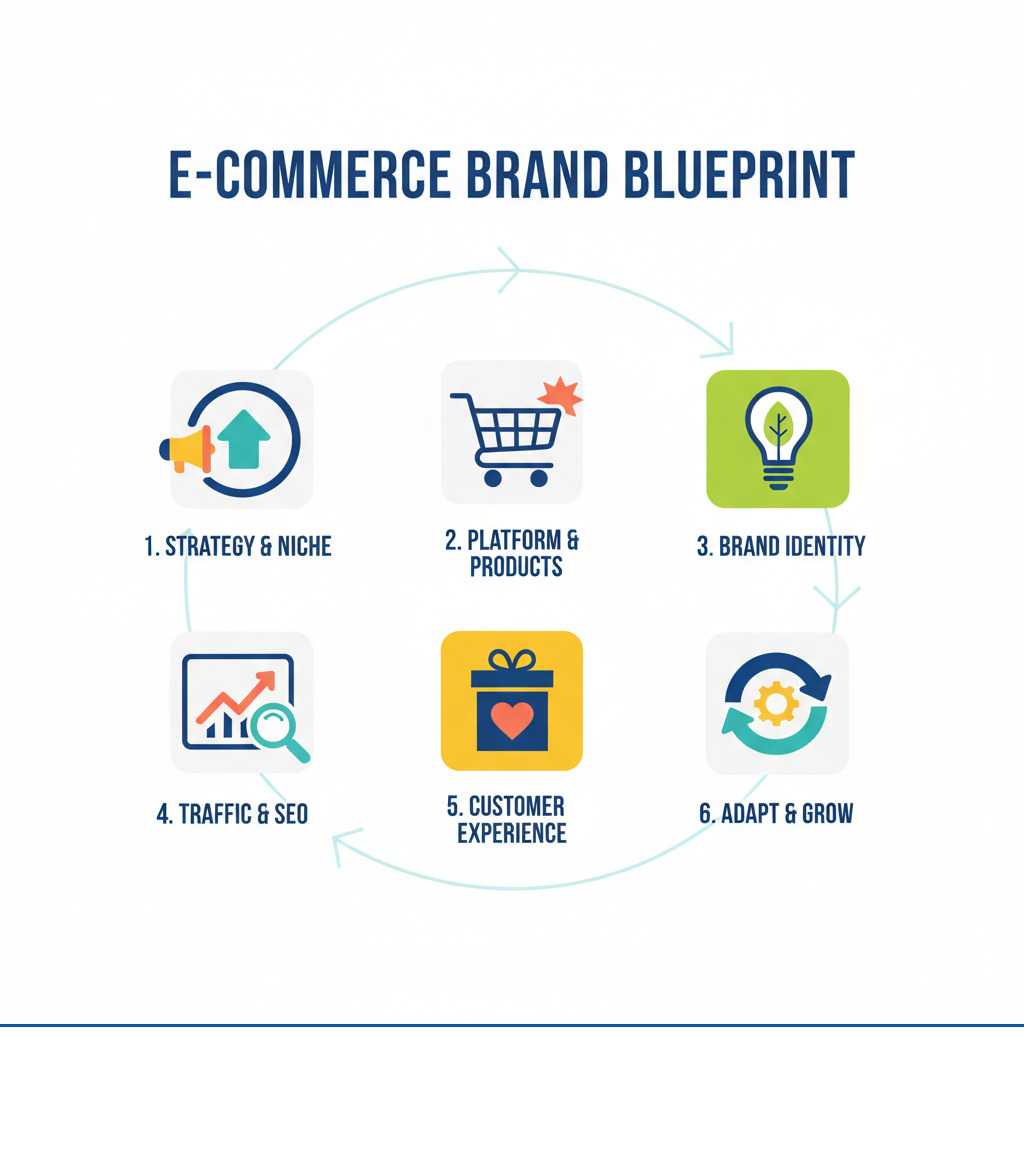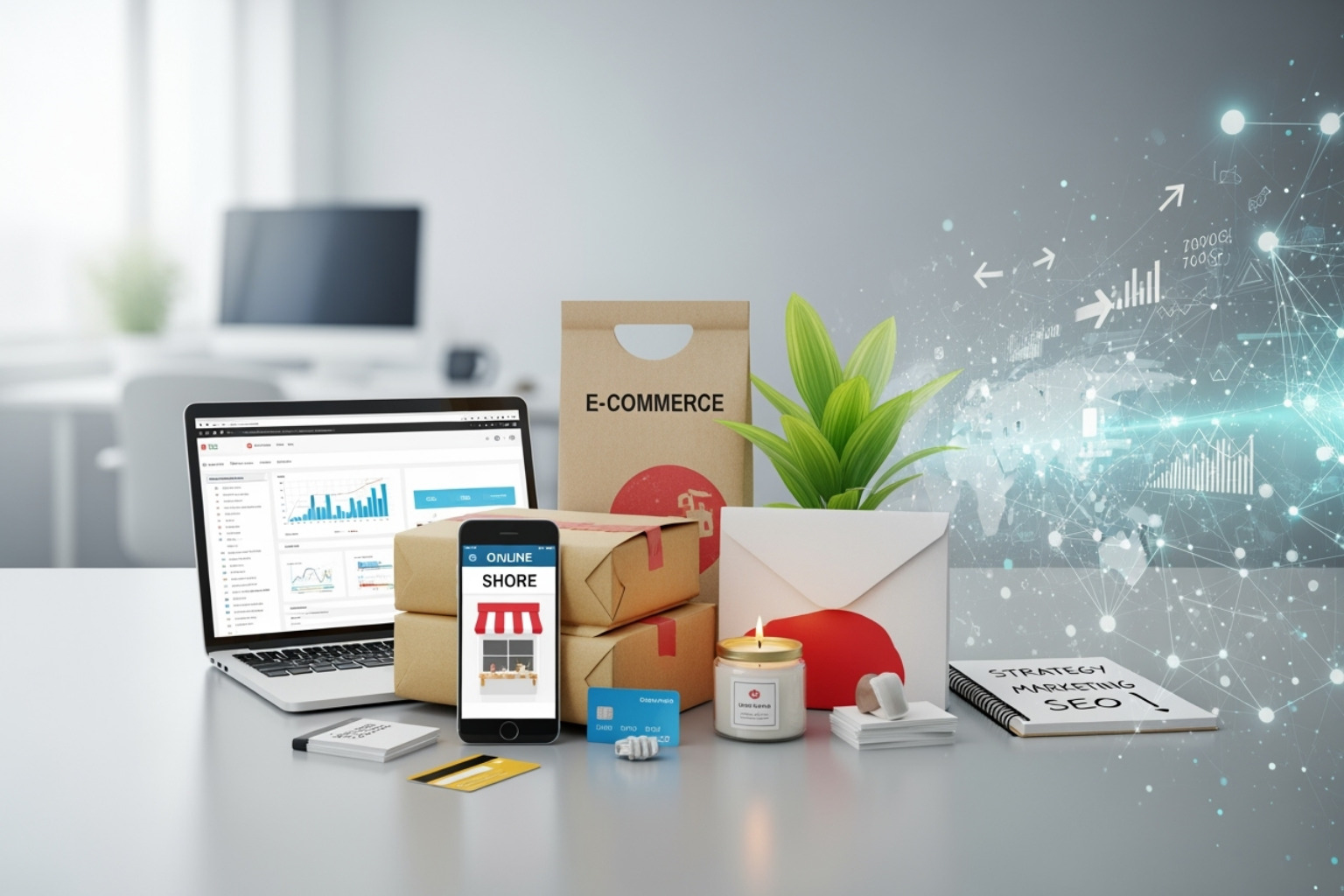Why Now is the Time to Start Your Ecommerce Business
How to build a successful ecommerce brand starts with understanding the opportunity. Here's what you need to know:
- Choose the right business model (B2C, B2B, D2C, subscription)
- Conduct market research to find your niche and target audience
- Define your brand identity including mission, values, and visual elements
- Set up your online store on a platform like Shopify
- Develop operational processes for shipping, inventory, and customer service
- Launch strategic marketing campaigns
- Focus on customer experience through personalization and loyalty programs
- Stay current with trends like AI, social commerce, and mobile optimization
The numbers tell the story. In 2021, US retail ecommerce hit roughly $768 billion, and that figure is projected to exceed $1.3 trillion by 2025. Globally, ecommerce sales are expected to reach $8.09 trillion by 2028. According to the US Census Bureau, ecommerce accounted for 16.4 percent of total sales in Q4 2024.
Beyond growth, ecommerce offers advantages over traditional retail. You'll have lower startup costs without rent, global reach beyond geographical limits, and the flexibility to adapt based on data and customer feedback. You can even launch with dropshipping or print-on-demand models that require little upfront investment.
But with 40% of internet users shopping online, building a brand that stands out is key. Many people stick to brands they know, which is why a strategic approach to branding is so important for ecommerce success.
I'm Steve Pogson, founder of First Pier. With over two decades as a Shopify Expert, my team and I have helped countless businesses learn how to build a successful ecommerce brand from scratch. We scale stores by combining platform expertise with proven growth strategies.

Stage 1: Laying the Foundation for Your Brand

It's tempting to rush into an ecommerce business, but my experience shows that successful brands take the time to build a solid foundation first.
It's like building a house; you need a foundation before putting up walls. Early steps like business planning, niche selection, and market analysis are essential for long-term growth. Entrepreneurs who invest time in planning are the ones who thrive years later.
Choosing the Right Business Model
Your business model is how you'll make money. The right choice depends on your product, resources, and customers.
We usually explore several options with new clients. Business-to-Consumer (B2C) is direct selling to individuals. Business-to-Business (B2B) involves selling to other companies, often with larger orders and longer sales cycles. Direct-to-Consumer (D2C) means you, the creator, sell straight to customers, controlling the entire experience.
The subscription model offers predictable revenue through regular customer payments. For lower startup costs, dropshipping lets you sell without holding inventory, as the supplier ships directly to your customer. Print-on-demand is similar, where products are created only after an order is placed.
If you're a maker or handle your own manufacturing, you have full control over quality. Wholesale involves selling in bulk to retailers.
Match the model to your situation. Consider if you're designing products, have capital for inventory, or want to handle fulfillment. For a deeper look at how these models compare, check out our guide to ecommerce business models.
Conducting Smart Market Research
Market research might sound dry, but it saves you from costly mistakes by showing you what's happening in the market before you invest. Think of it as an insurance policy against failure. It reveals opportunities, customer desires, and competitor weaknesses.
Start by looking at what products are in demand. Study successful competitors to understand what they do well and where they fall short—their customers' complaints are your opportunities. Also, understand broader market trends, like a growing interest in sustainability or a move to mobile shopping.
Most importantly, understand your audience's real needs and pain points. When you know how your product can genuinely help them, your marketing becomes much easier. Tools like our ecommerce analytics software can help you dig into data, and keyword research reveals the exact language your customers use.
Finding Your Niche and Profitable Products
After your research, find your spot in the market. You don't need a brand-new idea, just a way to add real value. Look for underserved markets—groups whose needs aren't fully met. These gaps are opportunities.
Pay attention to online trends with tools like Google Trends to see what's gaining momentum. The goal is to find a growing trend where you can offer something great.
A product must be profitable, not just popular. Calculate your sourcing, shipping, platform, and marketing costs to ensure the business is worthwhile. You also need reliable suppliers, whether you're manufacturing, wholesaling, or dropshipping.
As Eric Even Haim from ReConvert notes, focus on growing trends and underserved markets where you can excel. I believe in quality over quantity. Start with a focused product line and master it. You can always expand later, but trying to be everything to everyone rarely works.
For more detailed guidance on this process, take a look at our tips for finding a profitable product.
Stage 2: How to Build a Successful Ecommerce Brand Identity

Now for the exciting part: creating a memorable brand. Your brand identity is more than a logo; it's your business's personality, the feeling you create, and the story that sets you apart.
At First Pier, I've seen strong brands create loyal fans who return. This emotional connection turns browsers into buyers and advocates for your brand. For a complete blueprint, check out our Ecommerce Brand Strategy.
Defining Your Target Audience and Brand Mission
To tell your brand story, you need to know your audience and what you stand for. Many businesses skip this and their marketing fails.
Understand your customers beyond basic info like their age or location. Dig into their interests, values, and lifestyles. Creating detailed profiles of your ideal customer helps bring them to life. For B2B, specify the types of businesses you'll serve and their problems.
With your audience defined, create your vision statement (the future you want to create) and your mission statement (what you do daily to get there). Beardbrand’s vision is "To change the way society views beardsmen," while its mission is "To foster style for urban beardsmen." This clarity guides every decision.
Understanding your audience makes everything easier, from marketing copy to SEO. Your brand will feel like it was made just for them. More on defining your target audience can help you nail this step.
Creating a Unique Value Proposition (UVP) and Brand Story
Your Unique Value Proposition (UVP) answers one question: "Why should I buy from you?" It's not a list of features, but a clear statement of the problem you solve and why you're the best solution.
A simple template is: "We help [who] with [what] by [how]." For example: "We help growing ecommerce brands increase conversions with expert Shopify optimization." Your UVP should be front and center on your website.
Your brand story adds an emotional layer to your UVP. People connect with ideas and values. Sharing your origin story and purpose builds authenticity and trust. Think of Ben & Jerry's or Warby Parker—their genuine stories help customers connect on a human level. When you share your values, you become a business people want to support.
At First Pier, we specialize in building brand identity that combines a strong UVP with an authentic story.
Designing Your Visual Brand Identity
Your visual identity is how customers instantly recognize you across all platforms, from social media to your packaging.
Your logo is your brand's face. It should be simple, memorable, and distinctive. Color psychology is powerful; the right colors can increase brand recognition by up to 80%. They trigger emotional responses, so choose a palette that reflects your brand's personality.
| Color | Associated Emotions |
|---|---|
| Red | Passion, energy, love, romance, comfort |
| Black | Modernity, power, strength, intelligence, glamour |
| Blue | Security, loyalty, trust, stability |
| Green | Nature, health, growth, freshness |
| Pink | Warmth, love, nurture, softness |
| Yellow | Optimism, joy, intellect, happiness |
| Orange | Enthusiasm, creativity, determination, success |
| Purple | Royalty, luxury, ambition, wisdom |
| Brown | Reliability, earthiness, simplicity, honesty |
| White | Purity, innocence, cleanliness, simplicity |
Your typography also communicates personality. Whether traditional, modern, or neat, ensure it's readable on all devices. Your website design is your digital storefront and should be clean, intuitive, and visually aligned with your brand.
Don't overlook packaging design. According to Dotcom Distribution, 52% of consumers are more likely to make repeat purchases from merchants with premium packaging. The "unboxing experience" is a powerful marketing tool that can turn customers into brand ambassadors.
Consistency across all visual elements is critical. Your logo, website, social media, and packaging should all feel connected. This builds brand recognition and trust with every customer interaction.
Stage 3: Building and Launching Your Online Store

With your foundation and brand identity set, it's time to build your online store. This stage turns your plans into a working website. It involves choosing a platform, handling legal tasks, and planning your daily operations. Our ecommerce website development services are designed to make this smooth.
Naming and Legalizing Your Business
Choosing a business name is important, but don't let it paralyze you. Your business choices will define your success more than the name itself.
Make sure your name is available by checking your local secretary of state's website and the US Patent and Trademark Office. This avoids future legal issues.
Next, choose your legal structure. A sole proprietorship is simple but offers no personal asset protection. I usually recommend an LLC (Limited Liability Company) to small business owners because it separates your personal and business liabilities. A corporation may suit larger operations but is more complex.
Next, formally register your business. Get an EIN from the IRS to separate business and personal finances. Also, research any necessary permits and licenses for your industry and location. These legal steps are essential for legitimacy and protection.
Setting Up Your Ecommerce Website
Your website is where your brand comes alive. I usually recommend Shopify because it's user-friendly yet powerful, with all the features you need to set up a professional store and scale.
The setup is straightforward: choose and customize a theme, add your products with good descriptions, and set up payment gateways. For a complete walkthrough, check out our guide on how to build a Shopify store.
A Product Information Management (PIM) system is a game-changer. It centralizes all your product data—titles, descriptions, pricing—in one place. This is especially valuable if you sell on multiple channels, as it ensures consistency and can be integrated with Shopify.
Product photography is non-negotiable. Since customers can't touch your products, high-quality images from multiple angles are essential for building confidence. Pair them with product descriptions that tell a story and solve a customer's problem, speaking to the pain points you've already identified.
Outlining Your Operations and Processes
A great website is just the start. You need solid operations to run smoothly. Planning your processes from the beginning prevents chaos later.
Map out your daily operations, including order fulfillment and customer service. Your shipping strategy is also key—decide on carriers, costs, and delivery times. Good shipping experiences boost customer satisfaction.
Inventory management helps you track stock and avoid overselling. Have a clear customer service plan for handling questions and returns. A clear guide to customer support can turn problems into loyalty-building opportunities. Finally, set up payment processing and a financial planning system to track costs and budget.
Documenting these processes ensures consistency, makes delegation easier, and helps new team members. It's the operating system for your business.
Stage 4: Marketing Your Brand and Fostering Customer Loyalty
Your store is live and running. Now it's time for marketing. This isn't just about getting the first sale; it's about building connections with customers who will become loyal fans. You'll attract new customers and turn them into brand advocates. The best strategy is custom to your audience, budget, and brand personality. For a complete roadmap, explore our Ecommerce Marketing Plan.
How to build a successful ecommerce brand with smart marketing
Smart marketing means choosing the right channels to reach your customers.
Ecommerce SEO is your long-term growth engine. This means optimizing your site so people find you through search engines. As SEO consultant James Taylor says, "The sooner you have an approach to link building...the sooner search engines will recognize your website as an authority." Our Ecommerce SEO services can help.
Content marketing builds trust. Create helpful content for your audience, like blog posts, product videos, or podcasts. It doesn't need to go viral, just be valuable.
Social media marketing is where your brand's personality shines. Be authentic and interact with your followers. User-generated content is powerful; real customer experiences carry more weight than ads. Encourage customers to share photos and reviews.
Email marketing has a high ROI. Build your list early. Send personalized, segmented campaigns with relevant offers. This is great for nurturing new subscribers and re-engaging past customers.
Paid advertising on platforms like Google and Facebook can speed up growth. As Stephen Light of Nolah says, success in paid ads comes from testing and analysis. Experiment with different ads and audiences to see what works, then scale it.
Influencer marketing can introduce your brand to new audiences. Partner with influencers whose values and audience align with your brand. Authenticity is more important than follower count.
Creating an Unforgettable Customer Experience
Acquiring a new customer is important, but retention is key. A great customer experience turns one-time buyers into lifelong advocates.
Premium packaging and the unboxing experience are powerful retention tools. A thoughtful unboxing experience—even something simple like a handwritten note—can create a lasting impression and encourage social sharing.
Use loyalty programs and personalization to show you value your customers. Reward them with exclusive perks and personalize offers based on their purchase history. This shows you see them as individuals.
Outstanding customer service can be a huge advantage. Respond quickly, handle problems well, and exceed expectations. Great service creates loyal advocates for your brand. For strategies that keep customers coming back, check out our ecommerce retention strategies.
How to build a successful ecommerce brand by staying ahead of trends
The ecommerce world moves fast. Staying informed about new trends is essential. You don't have to adopt every trend, but understand how they might help your business.
Social commerce on platforms like Instagram and TikTok allows customers to buy directly within the app, reducing friction.
Artificial Intelligence (AI) allows for personalized shopping experiences, automates tasks, and can even speed up content creation.
Augmented Reality (AR) lets customers "try before they buy" through their phones, which can reduce returns and increase confidence.
Sustainability and ethical sourcing are increasingly important to consumers. Aligning your brand with a cause you care about shows you're about more than just profit.
Mobile commerce continues to grow. Ensure your store is fully optimized for a fast, smooth experience on phones and tablets.
Embracing these trends is about finding creative ways to connect with customers and improve your business. For a deeper look at what's shaping the future of ecommerce, explore the latest e-commerce trends.
Frequently Asked Questions about Building an Ecommerce Brand
What are the first steps to starting an ecommerce business?
The first steps combine strategic thinking and practical planning. Start with market research to find a viable niche and a product that solves a real problem. Then, create a business plan outlining your goals, target audience, and strategy. Finally, choose an ecommerce business model that fits your product and resources.
How much does it cost to start an ecommerce brand?
Costs vary, but you can start lean. Expect costs for platform fees (Shopify starts around $29/month), a domain name, and possibly inventory if you're not dropshipping. You'll also need a marketing budget. Many start with personal savings. First-year costs can be in the thousands, but you can start small and scale.
What makes an ecommerce brand successful?
A successful ecommerce brand is built on a few key pillars. First, a high-quality, in-demand product for a specific audience. Second, a strong brand identity that connects with customers. Third, a user-friendly website experience. Finally, consistent marketing and excellent customer service. It often takes 18 to 24 months to get going, so patience is key!
To Sum Up: Your Next Steps to Ecommerce Success
We've covered the complete roadmap on how to build a successful ecommerce brand, from initial planning and research to building your store and attracting customers. It's been a detailed trip.
Here's what I want you to remember most: consistency matters. Your brand message, product quality, and customer treatment must be consistent. Your mission and vision will guide you through challenges.
Building an ecommerce brand takes time, often 18 to 24 months to find its footing. But every step builds on the last, creating a stronger business.
At First Pier, my team and I love helping entrepreneurs like you. We specialize in Shopify development and optimization to give you a stable, feature-rich platform for growth. We don't just build websites; we build lasting brands.
If you're ready to create a strong online presence, I'd love to work with you. Check out our solutions for building and refining brands. Let's turn your vision into a reality and build something great together.







